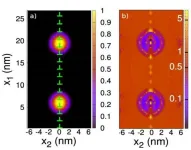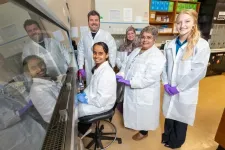(Press-News.org) Materials are often considered to be one phase, but many engineering materials contain two or more phases, improving their properties and performance. These two-phase materials have inclusions, called precipitates, embedded in the microstructure. Alloys, a combination of two or more types of metals, are used in many applications, like turbines for jet engines and light-weight alloys for automotive applications, because they have very good mechanical properties due to those embedded precipitates. The average precipitate size, however, tends to increase over time-in a process called coarsening-which results in a degradation of performance for microstructures with nanoscale precipitates.
Researchers at the University of Illinois Urbana-Champaign have identified a novel pathway to stabilize the nanoscale precipitates in alloys. In a new study, materials science and engineering professor Pascal Bellon, postdoctoral researcher Gabriel Bouobda Moladje and their collaborators show that it is possible to utilize nonequilibrium processes to stop precipitate coarsening, which results in stable nanostructures.
The results of this research were recently published in Physical Review Letters.
“In the last two decades, researchers have realized that having nanoscale inclusions in the structure that can actually be very beneficial to the material,” Bellon says. “The challenge is that spontaneously, these small particles want to grow bigger.”
Think of it like making pasta: when oil is added to the boiling water, the oil drops may be small when first added and stirred, but if stirring is stopped, the droplets will combine together to form larger drops. This is the coarsening process. “If we are interested in the distribution of small-scale objects, we have to work against this natural tendency for things to coarsen,” Bellon explains.
The team used computational modeling to investigate precipitates formed at the domains between different crystals of the material, called grain boundaries, when subjected to irradiation, a nonequilibrium force. In an equilibrium environment, forces are balanced and there is no net change to the material. In most applications, however, hard materials are subjected to nonequilibrium forces like irradiation, or even stirring. Therefore, it is important to understand how precipitates evolve in such nonequilibrium environments.
“We were particularly interested in alloys subjected to energetic particle irradiation,” Bellon says. “This is a situation that, for instance, happens in materials used for nuclear applications. It's also the case for materials used in space, where they are bombarded by cosmic rays. What we were specifically looking at was a model alloy of aluminum and antimony.”
In alloys of aluminum and antimony, antimony wants to form precipitates, like oil wants to form droplets in water. The researchers found that when irradiated, precipitates would form at the grain boundaries as expected. But they also found that instead of coarsening and continuing to grow, the precipitates would reach a certain size, and stop. This is called arrested coarsening behavior and was an unexpected result.
This approach could be applied to other materials systems where the transport of species plays an important role, like the transport of ionic species between electrodes in batteries. In battery materials, it can be advantageous to have small precipitates, since large precipitates can generate a lot of stress to the material. In such a case, the suppression of coarsening would be beneficial.
Following this computational research, Bellon, along with UIUC MatSE professors Robert Averback and Marie Charpagne, plan to start exploring experimental validation of the results recently published. Bellon says, “We’re excited to combine modeling, theory and experiments, while taking advantage of all the Materials Research Laboratory tools, to test the predictions from computer simulations at an experimental level.”
*
Other contributors to this work include Robert Averback (Department of Materials Science and Engineering at the University of Illinois Urbana-Champaign) and Ludovic Thuinet (Materials and Transformations Unit at the University of Lille, France).
This research was funded by the U.S. Department of Energy, Office of Science, Basic Energy Sciences.
END
Stabilizing precipitate growth at grain boundaries in alloys
2023-09-20
ELSE PRESS RELEASES FROM THIS DATE:
Researchers discover biomarker for tracking depression recovery
2023-09-20
Using a novel deep brain stimulation (DBS) device capable of recording brain signals, researchers have identified a pattern of brain activity or “biomarker” related to clinical signs of recovery from treatment-resistant depression. The findings from this small study are an important step towards using brain data to understand a patient’s response to DBS treatment. The study was published in Nature and supported by the National Institutes of Health’s Brain Research Through Advancing ...
NIH awards $3.1 million to study human mitochondrial disorders
2023-09-20
The Eunice Kennedy Shriver National Institute of Child Health and Human Development awarded $3.1 million to the University of Arkansas to study a spectrum of pediatric mitochondrial disorders caused by mutations in the mitochondria. These disorders often impact different organs requiring energy and can lead to mitochondria-induced multiple organ disorder syndromes, or MIMODS.
Shilpa Iyer, an associate professor of biological sciences, will serve as the principal investigator on the five-year award. Iyer and her team conduct research on mitochondrial diseases and have received grants from Arkansas ...
Newly discovered bone stem cell causes premature skull fusion
2023-09-20
Craniosynostosis, the premature fusion of the top of the skull in infants, is caused by an abnormal excess of a previously unknown type of bone-forming stem cell, according to a preclinical study led by researchers at Weill Cornell Medicine.
Craniosynostosis arises from one of several possible gene mutations, and occurs in about one in 2,500 babies. By constricting brain growth, it can lead to abnormal brain development if not corrected surgically. In complex cases, multiple surgeries are needed.
In the study, which appears Sept. 20 in Nature, the researchers examined in detail what happens in the skull of mice with one of the most common mutations found in human ...
Disrupting a core metabolic process in T cells may improve their therapeutic efficacy
2023-09-20
SEPTEMBER 20, 2023, NEW YORK – In exploring an aspect of how killer T cells generate the raw materials required for their proliferation, a Ludwig Cancer Research study has uncovered an unexpected link between the immune cells’ metabolism, regulation of gene expression, persistence and functional efficacy that could be exploited using existing drugs to improve cancer immunotherapy.
Researchers led by Ludwig Lausanne’s Alison Jaccard and Ping-Chih Ho along with their University of Lausanne colleagues Mathias Wenes and Pedro Romero were exploring how proliferating T cells in the low-oxygen environment of tumors make citrate, a molecule essential to manufacturing membranes, which ...
Exercise and muscle regulation: implications for diabetes and obesity
2023-09-20
How do our muscles respond at the molecular level to exercise? Researchers at Helmholtz Munich and the German Institute of Human Nutrition Potsdam-Rehbrücke (DIfE) have unraveled the cellular basis and signaling pathways responsible for the positive impact of physical activity on our overall health. Regulatory T cells, a type of immune cell, play a critical role in ensuring proper muscle function. These novel insights are paving the path towards precision medicines targeting metabolic disorders like obesity and diabetes, as well as muscle-related illnesses. Their discoveries are published in Cell Metabolism.
Obesity and type ...
Study reveals structure of crucial receptor in brain development, function
2023-09-20
Scientists have revealed the molecular structure of a type of receptor that’s crucial to brain development and function.
Known as Type A GABA receptors, these receptors are already targeted by pharmaceutical anesthetics, sedatives and antidepressants because of their important role in brain function. The discovery, published today in the journal Nature, reveals the dominant assemblies and states of the GABA receptor, a finding that could enable the development of new compounds that more specifically target a range of medical disorders.
“It is the main player that balances excitation and inhibition in the ...
How to tackle the global deforestation crisis
2023-09-20
Imagine if France, Germany, and Spain were completely blanketed in forests — and then all those trees were quickly chopped down. That’s nearly the amount of deforestation that occurred globally between 2001 and 2020, with profound consequences.
Deforestation is a major contributor to climate change, producing between 6 and 17 percent of global greenhouse gas emissions, according to a 2009 study. Meanwhile, because trees also absorb carbon dioxide, removing it from the atmosphere, they help keep the Earth cooler. ...
Language acquisition may work differently in people with autism
2023-09-20
You’re looking at a truck. You’re with a young child and he follows your gaze. He’s interested in the object you’re looking at without you pointing at it. This is called joint attention and it is one of the primary ways children learn to connect words with objects and acquire language.
Lack of joint attention is a core feature of autism. Until now, it was thought that stimulating joint attention in people with autism would help them express themselves verbally. But a meta-analysis of 71 studies on autism challenges this assumption and suggests that people with autism spectrum disorders may acquire language differently.
The study – by Laurent Mottron, ...
Upgrading iron and steel plants could save equivalent of two years of global carbon emissions
2023-09-20
Upgrading, or retrofitting, the world's iron and steel processing plants early could reduce carbon emissions by up to 70 gigatonnes by 2050, roughly equivalent to two years' worth of net global carbon emissions, according to a new study led by UCL researchers.
Published in the journal Nature, the researchers found that by upgrading the world’s iron and steel production facilities, carbon emissions can be reduced by 58.7 gigatonnes between 2020 and 2050, roughly equivalent to two years’ worth of net global carbon emissions. ...
Genetically modifying individual cells in animals
2023-09-20
One proven method for tracking down the genetic causes of diseases is to knock out a single gene in animals and study the consequences this has for the organism. The problem is that for many diseases, the pathology is determined by multiple genes. This makes it extremely difficult for scientists to determine the extent to which any one of the genes is involved in the disease. To do this, they would have to perform many animal experiments – one for each desired gene modification.
Researchers led by Randall Platt, Professor of Biological Engineering at the Department of Biosystems Science and Engineering at ETH Zurich in Basel, have now developed a method that will greatly ...






